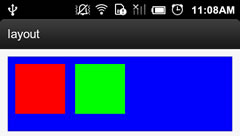onLayout方法是ViewGroup中子View的布局方法,用于放置子View的位置。放置子View很简单,只需在重写onLayout方法,然后获取子View的实例,调用子View的layout方法实现布局。在实际开发中,一般要配合onMeasure测量方法一起使用。
onLayout方法:
[java] view plaincopy
@Override
protected abstract void onLayout(boolean changed,
int l, int t, int r, int b);
该方法在ViewGroup中定义是抽象函数,继承该类必须实现onLayout方法,而ViewGroup的onMeasure并非必须重写的。View的放置都是根据一个矩形空间放置的,onLayout传下来的l,t,r,b分别是放置父控件的矩形可用空间(除去margin和padding的空间)的左上角的left、top以及右下角right、bottom值。
layout方法:
[java] view plaincopy
public void layout(int l, int t, int r, int b);
该方法是View的放置方法,在View类实现。调用该方法需要传入放置View的矩形空间左上角left、top值和右下角right、bottom值。这四个值是相对于父控件而言的。例如传入的是(10, 10, 100, 100),则该View在距离父控件的左上角位置(10, 10)处显示,显示的大小是宽高是90(参数r,b是相对左上角的),这有点像绝对布局。
平常开发所用到RelativeLayout、LinearLayout、FrameLayout...这些都是继承ViewGroup的布局。这些布局的实现都是通过都实现ViewGroup的onLayout方法,只是实现方法不一样而已。
下面是一个自定义ViewGroup的Demo,用onLayout和layout实现子View的水平放置,间隔是20px
[java] view plaincopy
public class MyViewGroup extends ViewGroup {
// 子View的水平间隔
private final static int padding = 20;
public MyViewGroup(Context context, AttributeSet attrs) {
super(context, attrs);
// TODO Auto-generated constructor stub
}
@Override
protected void onLayout(boolean changed, int l, int t, int r, int b) {
// TODO Auto-generated method stub
// 动态获取子View实例
for (int i = 0, size = getChildCount(); i < size; i++) {
View view = getChildAt(i);
// 放置子View,宽高都是100
view.layout(l, t, l + 100, t + 100);
l += 100 + padding;
}
}
}
Activity的XML布局:
[html] view plaincopy
<RelativeLayout xmlns:android="http://schemas.android.com/apk/res/android"
xmlns:tools="http://schemas.android.com/tools"
android:layout_width="match_parent"
android:layout_height="match_parent"
android:padding="10dp" >
<com.example.layout.MyViewGroup
android:layout_width="match_parent"
android:layout_height="100dp"
android:background="#0000ff" >
<View
android:layout_width="match_parent"
android:layout_height="match_parent"
android:background="#ff0000" />
<View
android:layout_width="match_parent"
android:layout_height="match_parent"
android:background="#00ff00" />
</com.example.layout.MyViewGroup>
</RelativeLayout>
效果如图所示:

上图MyViewGroup是蓝色,两个子View分别为红色和绿色。
在自定义View中,onLayout配合onMeasure方法一起使用,可以实现自定义View的复杂布局。自定义View首先调用onMeasure进行测量,然后调用onLayout方法,动态获取子View和子View的测量大小,然后进行layout布局。
评论